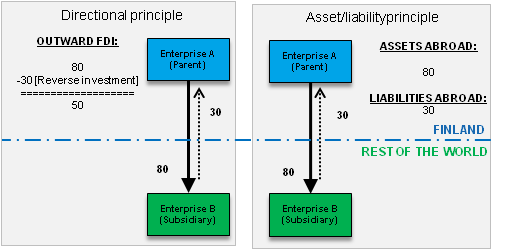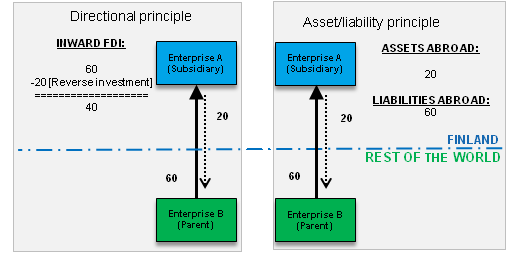2. Reform of statistics on foreign direct investments
The Organisation for Economic Co-operation and Development (OECD) and the International Monetary Fund (IMF) have published their new manuals concerning the compilation of statistics on foreign direct investments (OECD: Benchmark Definition of Foreign Direct Investment, 4th ed. [BD4]) and on balance of payments (IMF: Balance of Payments and International Investment Position Manual, 6th ed. [BPM6]). In Finland, data on balance of payments and international investment position have been released according to the extended balance of payments manual since 11 July 2014. For statistics on foreign direct investments, the compilation of statistics according to the new directional principle is taken into use starting from the statistical reference year 2013 in connection with this publication on 18 November 2014.
As a result of globalisation and deregulation of financial markets, intra-group ownership and financing structures have become more complex and this statistics reform attempts to meet this challenge. As a result, current international FDI statistics tend to reflect the occurrence mentioned above rather than foreign real investments, as was previously the case. The number of so-called pass-through investments in direct investments has grown considerably. The statistics reform aims to eliminate ‘inflation’ of FDI data due to capital passing through groups’ internal holding and financing units. This is achieved by netting debt items between fellow enterprises according to the extended directional principle. In addition, it becomes easier to identify the ultimate investing country or the ultimate direct investor country in inward FDI.
The statistics reform causes a break in the time series in the statistics on direct investments in accordance with the directional principle. In data released on Statistics Finland's website concerning years prior to the statistical reference year 2013, direct investments are given according to the previous directional principle and starting from the statistical reference year 2013, direct investments are presented according to the extended directional principle. For the years prior to the statistical reference year 2013, the Bank of Finland has estimated the capital stock and items between fellow enterprises in accordance with the extended directional principle for the years 2009 to 2012 for the IMF's Coordinated Direct Investment Survey (CDIS). The data of the CDIS can be found on the IMF website at: http://cdis.imf.org/ . For the year 2008, data on capital stock and items between fellow enterprises in accordance with the extended directional principle have been presented in the Bank of Finland's BoF Online publication where the statistics reforms that apply to direct investments have also been discussed at a more detailed level ( http://www.suomenpankki.fi/fi/julkaisut/selvitykset_ja_raportit/bof_online/Documents/BoF_Online_04_2011.pdf ).
2.1 Effects of the statistics reform on the figures published
The stock of inward FDI contracts by about six per cent as a result of the statistics reform. Correspondingly, the stock of outward FDI reduces by approximately ten per cent. The total impact of the change is EUR 6,937 million in both directions, that is, the impact is of the same size for both Finland’s inward and outward FDI.
Table 1. Summary of outward and inward FDI in 2013 according to the current (BPM6/BD4) and previous (BPM5/BD3) statistics manuals, EUR mil.
| BPM6/BD4 | BPM5/BD3 | New/Old (%) | |
| OUTWARD FDI | 106 896 | 113 833 | 94 |
| INWARD FDI | 63 153 | 70 090 | 90 |
| Net | 43 743 | 43 743 | 100 |
The contraction in the stock of FDI is explained by a change in the division of debt capital items. Tables 2 and 3 below describe in more detail how the treatment of debt assets and liabilities between fellow enterprises has changed when moving to the extended directional principle. FDI data do not include equity investments between fellow enterprises, for which reason the statistics reform has no effect on equity. 1)
Table 2. Outward FDI stock according to both the current (BPM6/BD4) and previous (BPM5/BD3) statistics standards at the end of 2013, EUR mil.
| BPM6/BD4 | BPM5/BD3 | |
| OUTWARD FDI | 106 896 | 113 833 |
| Equity | 101 167 | 101 167 |
| Debt instruments = | 5 729 | 12 666 |
| + Assets in direct investment enterprises | 23 709 | 23 709 |
| - Liabilities to direct investment enterprises (reverse investments) | -17 292 | -17 292 |
| + Assets in foreign fellow enterprises | 6 249 | |
| + Assets in foreign fellow enterprises where ultimate contolling parent is resident in Finland | 3 366 | |
| - Liabilities to foreign fellow enterprises where ultimate controlling parent is resident in Finland | -4 054 |
According to the previous directional principle, outward FDI (EUR 6,249 million) comprises all debt capital claims on fellow enterprises abroad, while the extended directional principle stipulates that outward FDI only comprises debt claims on fellow enterprises abroad where the ultimate controlling parent is resident in Finland (EUR 3,366 million). Claims on fellow enterprises abroad where the ultimate controlling parent is not resident in Finland (EUR 2,883 million) are transferred to reverse investment in inward FDI.
Table 3. Inward FDI stock according to both the current (BPM6/BD4) and previous (BPM5/BD3) statistics standards at the end of 2013, EUR mil.
| BPM6/BD4 | BPM5/BD3 | |
| INWARD FDI | 63 153 | 70 090 |
| Equity | 55 191 | 55 191 |
| Debt instruments = | 7 962 | 14 899 |
| + Liabilities to foreign direct investors | 13 074 | 13 074 |
| - Assets in foreign direct investors (reverse investments) | -6 691 | -6 691 |
| + Liabilities to foreign fellow enterprises | 8 516 | |
| + Liabilities to foreign fellow enterprises where ultimate controlling parent is resident abroad | 4 462 | |
| - Assets in foreign fellow enterprises where ultimate controlling parent is resident abroad | -2 883 |
According to the previous directional principle, inward FDI (EUR 8,516 million) includes all debt capital liabilities to fellow enterprises abroad. According to the extended directional principle, inward FDI includes only debt liabilities to fellow enterprises abroad where the ultimate controlling parent is resident abroad (EUR 4,462 million). Liabilities to fellow enterprises abroad where the ultimate controlling parent is resident in Finland (EUR 4,054 million) are transferred to reverse investment in outward FDI.
The sum of the transferred items, EUR 6,937 million (= 2,883+4,054), reflects the absolute impact of the statistical changes on FDI stocks. However, the changes do not affect the net FDI position, which is EUR 43,743 million according to both the current and previous statistical standards (see Table 1).
2.2 Two views on foreign direct investments
As a result of the statistics reform, direct investments in the statistics on balance of payments and international investment position are given in gross according to the asset/liability principle starting from the statistical reference year 2013 and the figures are also available for the period prior to this. Correspondingly, direct investments in the statistics on foreign direct investments are presented according to the extended directional principle starting from the statistical reference year 2013. Due to presentation differences, the figures given in the statistics on balance of payments and foreign direct investments differ from one another but are, however, consistent.
The example below illustrates the differences between the directional principle and the asset/liability principle in the statistics on direct investments by means of investment flows between Finland and abroad. Figure 4 shows Finland's outward FDI both based on the directional principle and the asset/liability principle. In outward FDI the group parent is located in Finland and the investment targets (subsidiaries/affiliates) abroad.
Figure 4. Finland's outward FDI according to the directional principle and the asset/liability principle, flow of direct investments

Figure 5 shows Finland's inward FDI based both on the directional principle and the asset/liability principle. In Finland's inward FDI, the group parent is located abroad. Correspondingly, investment targets (subsidiaries/affiliates) are located in Finland.
Figure 5. Finland's inward FDI according to the directional principle and the asset/liability principle, flow of direct investments

Table 4 shows a summary of investment flows between Finland and abroad. According to the directional principle, outward FDI is higher than inward FDI in this example. According to the asset/liability principle, Finland's foreign claims grew by 100 units. Respectively, Finland's foreign liabilities increased by 90 units.
Table 4. Summary of Finland’s FDI flows according to the directional and asset/liability principle.
| Directional principle | Asset/liability principle | ||
| OUTWARD FDI | 50 | Assets | 80+20=100 |
| INWARD FDI | 40 | Liabilities | 30+60=90 |
| Net | 10 | Net | 10 |
1) By definition, equity investments between fellow enterprises are possible if they entitle to a share of under ten per cent in the voting rights of the enterprise that is the target of the investment.
Source: Foreign direct investments 2013, Statistics Finland
Inquiries: Kristian Taskinen 029 551 2238, Laura Wallenius 029 551 2997, balanceofpayments@stat.fi
Director in charge: Leena Storg�rds
Updated 18.11.2014
Official Statistics of Finland (OSF):
Foreign direct investments [e-publication].
ISSN=2342-351X. 2013,
2. Reform of statistics on foreign direct investments
. Helsinki: Statistics Finland [referred: 24.4.2024].
Access method: http://www.stat.fi/til/ssij/2013/ssij_2013_2014-11-18_kat_002_en.html

